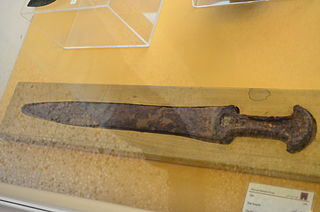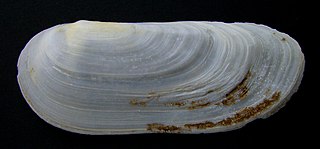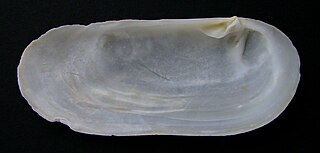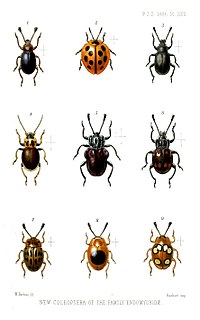This is a list of types of swords.

The makhaira is a type of Ancient Greek bladed weapon, generally a large knife or sword with a single cutting edge.

The acinaces, also spelled akinakes or akinaka is a type of dagger or short sword used mainly in the first millennium BC in the eastern Mediterranean region, especially by the Medes, Scythians and Persians, then by the Greeks.
Swords made of iron appear from the Early Iron Age, but do not become widespread before the 8th century BC.

Zenatia is a genus of medium-sized clams, marine bivalve molluscs in the family Mactridae.

Zenatia acinaces is a species of moderately large marine bivalve mollusc in the family Mactridae.

Endomychidae, or handsome fungus beetles, is a family of beetles with representatives found in all biogeographic realms. There are around 120 genera and 1300 species. The family was established based on the type genus Endomychus, a genus erected in 1795 by Panzer which was applied to a species that Linnaeus called Chrysomela coccinea. As the common name suggests, Endomychidae feed on fungi. Crowson, in his influential treatment of the beetles, placed the family within the Cucujoidea. They have a tarsal formal of 4-4-4 or 3-3-3 and the wings lack a closed radial cell. The second antennal segment has a sensory appendage that is as long as the third antennal segment. The family has also been grouped with the Coccinellidae in a group called the Trimera for having pseudotrimerous tarsi. A 2015 molecular phylogeny study found that the Cucujoidea were found to be non-monophyletic and the Endomychidae was refined with the removal of the Anamorphinae from within the family and elevated to the status of a full family, Anamorphidae. Mycetaeinae and Eupsilobiinae were also found not to belong within the clades of the core Endomychidae, and likewise reclassified into the families Mycetaeidae and Eupsilobiidae.

Cyprinion is a genus of ray-finned fish in the family Cyprinidae.
Cyprinion milesi is a species of ray-finned fish in the genus Cyprinion from Pakistan, Afghanistan and Iran.
Cyprinion tenuiradius is a species of ray-finned fish in the genus Cyprinion.
Cyprinion mhalensis is a species of ray-finned fish in the genus Cyprinion. It is endemic to the eastern part of the Sarawat Mountains in Saudi Arabia where it occurs in the upper reaches of wadis. It has been recorded from shallow, permanent and slow running water, as well as intermittent streams.
Cyprinion acinaces is a species of ray-finned fish in the genus Cyprinion. This species has two subspecies Cyprinion acinaces acinaces and Cyprinion acinaces hijazi, though the validity of the latter is in doubt. If C. a. hijazi is invalid, then C. acinaces would be monotypic. The species occurs from western, central and northern Saudi Arabia to Yemen.
Cyprinion microphthalmum is a species of ray-finned fish in the genus Cyprinion. This species may be a synonym of Cyprinion watsoni. If valid it is found in Iran, Pakistan, Afghanistan and the Arabian peninsula.

The razorbelly minnows are a group of fish in the genus Salmostoma found in southern Asia. They have been placed in the genus Salmophasia but this is regarded as a junior synonym of Salmostoma.

The silver razorbelly minnow Chela Maach in Bengali is a species of ray-finned fish in the carp family, Cyprinidae. It is native to India, where it occurs in many river systems. It has also been reported from Bangladesh.

Solen is a genus of marine bivalves in the family Solenidae.

Melligomphus acinaces is a species of dragonfly in the family Gomphidae. It is endemic to the streams of Western Ghats of India. This species was originally described as a Onychogomphus. However, both the pattern and the shape of the anal appendages do not fit Onychogomphus but are very close to those of the species placed in Melligomphus.

Lamelligomphus nilgiriensis is a species of dragonfly in the family Gomphidae. It is endemic to the hill streams of Western Ghats of India. This species has been placed by many authors in Onychogomphus but should be included in Lamelligomphus following Fraser (1934), based on the shape of the male anal appendages.
This page is based on this
Wikipedia article Text is available under the
CC BY-SA 4.0 license; additional terms may apply.
Images, videos and audio are available under their respective licenses.










